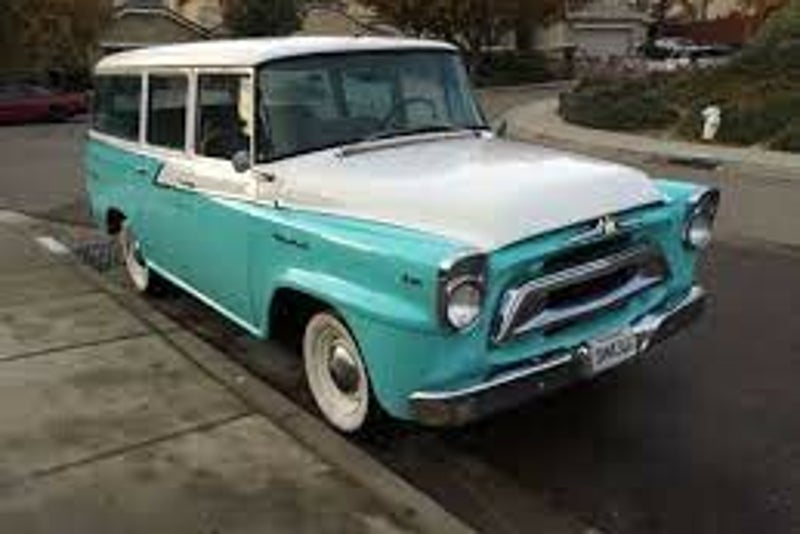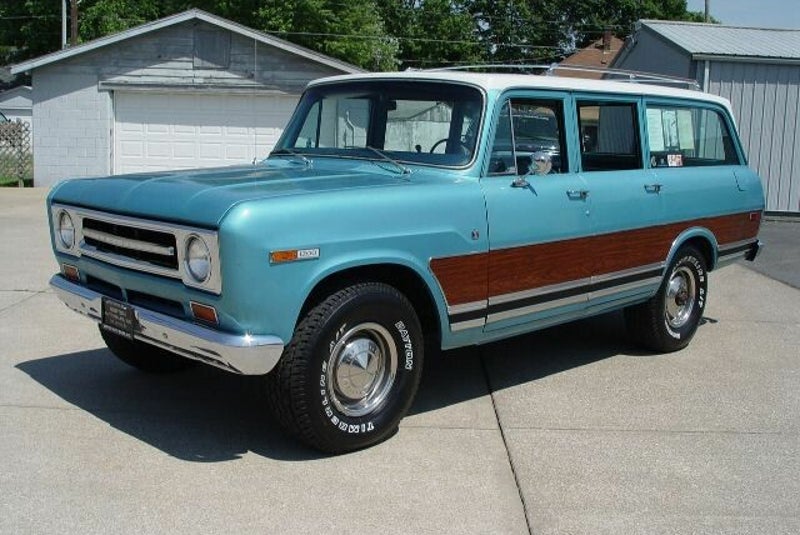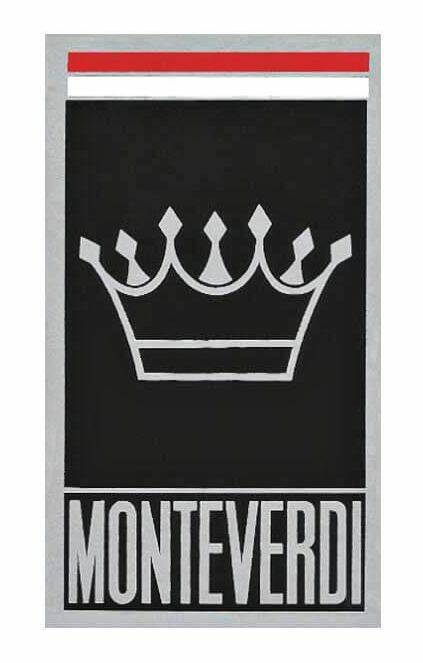


The International Harvester Company (often abbreviated by IHC or IH, or simply International was an American manufacturer of agricultural and construction equipment, automobiles, commercial trucks, lawn and garden products, household equipment, and more. It was formed from the 1902 merger of McCormick Harvesting Machine Company and Deering Harvester Company and three smaller manufactures.
IH dominated the market through the 1950s despite stiff competition from Ford, Allis Chalmers, Massey Ferguson and John Deere.

IH ranked 33rd among United States corporations in the value of World War II production contracts. In 1946 IH acquired a defense plant in Louisville, Kentucky, which was adapted for production of the Farmall A, B, and the new 340 tractors. It acquired the Metropolitan Body Company of Bridgeport, Connecticut, in 1948. The commercially successful Metro line of forward control vans and trucks were produced here from 1938 until 1964.
metro van

1938-1975



The International Metro Van, made by International Harvester, is a step van, also known as walk-in or multi-stop delivery truck. This vehicle type was one of the earlier, mass-produced forward control vehicles, once commonly used for milk or bakery delivery, as well as ambulance services, mobile offices, and radio transmitter vans. Typically, they were 1/2-, 3/4-, or 1-ton panel trucks that allowed the driver to stand or sit while driving the vehicle.
Variations included a passenger bus called a Metro Coach, a Metro partial cab-chassis with front-end sections (for end-user customization), and a cab-over truck called a "walk-in cab". The truck (also called a chassis cab) variation could be configured with a separate box or container for cargo transport or left open to be fitted with other equipment such as a compactor for a garbage truck or a stake bed.
L series

1940-1952



The International L series was introduced by International Harvester in fall 1949 as the replacement for the KB series and were available as everything from light pickup trucks and delivery vehicles to full-size tractor-trailers. Electric wipers, a radio, and a clock were optional. International would continue to produce the line until 1952 when it was replaced by the R series.
The lighter-duty versions were equipped with the all-new OHV "Silver Diamond" engines in two different sizes (220cid & 240cid), while the medium-duty versions retained the older 269 ci "Blue Diamond", also an OHV engine, although it was now called the "Super Blue Diamond" after some detail improvements. The BD-269 has the same peak power as the smallest, but offers more torque, at 301 N⋅m versus 260 N⋅m for the Silver Diamond 240. The L series was also built in Australia, where it was called the AL series.
A series

1957



The International A series (or A-line) replaced the S series in April 1957. The name stood for "Anniversary", as 1957 marked the fiftieth (or Golden) anniversary of truck production by International Harvester. It was largely a rebodied version of the light and medium S-series truck, incorporating a wide cab and more integrated fenders. A modified version of this truck range was also built in Australia until 1979, where it was marketed both as an International and as a Dodge.
The new lower design necessitated a slight hump in the cabin floor. The stylish new front end, deleted running boards, and panoramic windshield brought the design more up to date for the later half of the fifties on this, the first all-new design to appear since Ted Ornas was put in charge of design in 1953.
For 1959, the B series replaced the A series. This was the first of the series to feature V8 engines as an option, of either 304 ci or 345 ci.
light line

1969-1975



The International Light Line pickups (also called the International D-Series (1000–1500)) replaced the C-Series as International's Light Line range of pickup trucks in early 1969, for a shortened model year. The name started out as a simple continuation of the previous A-, B-, and C-series trucks. It was largely a rebodied version of its predecessors, with a square-rigged look very similar to the period Scout utility vehicle. The Travelall underwent parallel changes to the Light Line trucks. The light line of trucks was marked by a larger range of transmission and wheelbase options than any of its competitors, and in general the lineup aimed to maximize adaptability. The Light Line was also available as a bare chassis, for special purpose applications. Production ended partly replaced by new Scout Terra in late April 1975, as a hard-pressed International chose to focus on the Scout and on heavier machinery.
Pickup (and Travelall) production ended on 28 April 1975, with only about 6,000 made. The last one built was an all-wheel drive IH 200HD cab and chassis, built in IHC's Springfield factory. The Light Line was unable to compete with the Big Three in the light truck market; IHC's market share in this segment had never been higher than 9.5% and had dropped to 4.1% by 1969.
travelall

first generation (1953-1957)

second generation (1958-1960)

third generation (1961-1968)

fourth generation (1969-1975)
The International Harvester Travelall is a model line of vehicles that were manufactured by International Harvester; four generations were produced from 1953 to 1975. Derived from the International light truck line, the Travelall was a truck-based station wagon. One of the first competitors to the Chevrolet Suburban, the Travelall was a forerunner of modern people carriers and full-size sport utility vehicles.
first generation (1953-1957)
The travelall was introduced as a metal-bodied station wagon. Replacing the previous wood-bodied wagons, the Travelall was a windowed panel van with rear seats. The first-generation Travelall was offered in the R-110 series on the 115 in (2,921 mm) wheelbase. A 220 cubic-inch "Silver Diamond" I6 was rated at 100 hp.
second generation (1958-1960)
Introduced in 1957 for the 1958 model year, the A-series (for "Anniversary", marking fifty years of International Harvester truck production) offered a 2nd passenger side door for improved access to the rear seats. Models A-100, A-110, and A-120 all came with 113 to 154 hp six-cylinder engines, with four-wheel drive optional on the A-120. The design changes paralleled those of the A-series pickups.
third generation (1961-1968)
In April 1961 the Travelall underwent the same changes as the pickup range upon which it was based. The new C-series Travelall benefitted from a whole new chassis with all new independent front torsion bar suspension. Aside from the lower body, the most obvious visual difference were that the twin headlights were now mounted side-by-side, and a new grille of a concave egg-crate design.
fourth generation (1969-1975)
For 1969 production, International released the fourth-generation Travelall alongside the redesigned D-series pickups. Sized roughly between the Jeep Wagoneer and the Chevrolet/GMC Suburban, the Travelall was marketed as a truck-based station wagon. While still maintaining mechanical commonality with the Light Line pickup trucks, International had largely split the Travelall into a distinct model line, slotting it above the Scout.
In 1974, sales of the model line collapsed in response to the 1973 oil crisis and despite very high owner loyalty and satisfaction, International discontinued the Travelall in May 1975.







scout

1960-1965 scout 80

1965-1968 scout 800

1968-1970 800a

1970-1971 scout 800b
The International Harvester Scout is an off-road vehicle produced by International Harvester from 1961 to 1980. A precursor of more sophisticated SUVs to come, it was created as a competitor to the Jeep, and it initially featured a fold-down windshield. The Scout and second-generation Scout II were produced in Fort Wayne, Indiana, as two-door trucks with a removable hard top with options of a full-length roof, half-cab pickup, and/or soft top.
International Harvester began building trucks and pickups in 1907. In 1953, International added a truck-based people carrier, the Travelall. During the late 1950s, International began to design a competitor for the two-door Jeep CJ 4x4. The 1961 model year Scout 80 made its debut in late 1960.
Scout models include the:
- Scout 80 (1960–1965): The original.
- Scout 800 (1966–1971): Same overall design as original with upgrades (electric wipers, newer engines, etc.).
- Scout 810 (1971): Some early Scout IIs contain Scout 810 badging on the glove box.
- Scout II (1971–1980): The later standard production model with a removable soft or hard top (100-in wheelbase).
- Scout II Terra (1976–1980): The light pickup truck version (118-in wheelbase).
- Scout II Traveler (1976–1980): This version had a removable fiberglass hardtop, and optional third row of seats (118-in wheelbase).
- Super Scout II (1977–1979): This model had removable fabric doors, a rollbar, and soft top. The soft-top model was tagged the "SSII" by IH marketing. Eventually, the "SS" letters were assumed to stand for "Super Scout", the name this model is called presently.
scout 80
Scout 80s were built between 1960 and 1965. These models were identifiable by removable sliding side windows in 1960–1961 and even some very early 1962 models, a fold-down windshield, vacuum windshield wipers mounted to the top of the windshield, and an IH logo in the center of the grille and tailgate. The Scout 80 had the gasoline-powered 152 four-cylinder as its standard engine.
scout 800
The Scout 800 replaced the Scout 80 during 1965. The new 800 model was built from 1965 to 1968. These models had many improvements of comfort and design, including bucket seats, better instrumentation and heating systems, updated dashboard, optional rear seats, and optional 196 four-cylinder (from 1966), or 232 inline-six.
scout 800a
The 800A replaced the 800 during november 1968. Improvements included more creature-comfort options, a slightly different front-end treatment, drivetrain upgrades (heavier rear axle and quieter Dana 20 transfer case), and the options of a 196 four-cylinder, 232 six-cylinder, 266 V8, or 304 V8. The inline-six was only offered for a short period in early 1969. The 800A's grille was in three segments: the center grill and two matte-black headlight bezels. The Light Line of pickup trucks received bodywork similar to that of the Scout in late 1969.
scout 800b
The last of the 800 series was the 800B, available for less than eight months, from August 1970 until March 1971, before it was replaced with the Scout II. Other than minor cosmetic details (primarily chrome headlight bezels instead of matte black), it was identical to the 800A. It was only produced until the Scout II was in production.
scout II
Scout IIs were manufactured from April 1971 to 1980. The design was finalized much earlier, with a version nearly identical to the production model shown to management during December 1967. The Scout II is most identifiable by its different front grilles.
scout ssII (super scout II)
The SSII (Super Scout II) was a stripped-down, off-road version introduced in February 1977. It was intended to compete directly with the Jeep CJ, and was built until 1979. This model included a soft top with soft doors, windshield-mounted mirrors, plastic door inserts, special plastic grille, and a roll bar, among other options. Several SSIIs were champions on the off-road racing circuit during the late 1970s.
shawnee scout
The Shawnee Scout was to be a trim type and special-feature package model produced by Hurst Performance. This model was built by dressing up a black SSII with special tomahawk and feather decals, special seats, a black targa-style top, hard tonneau bed cover, and of course a Hurst shifter. Only three Shawnee Scouts were produced.
final "special" version
Probably one the rarest models ever produced by IH was the 1980 RS: the Special Limited Edition RS Scout. This version was only available on the Traveler in Tahitian Red (metallic). It had special extras inside and out.

1971-1980 scout II







monteverdi

The Monteverdi Safari was made by Monteverdi, the Swiss brand of luxury cars, who used Scout IIs to produce well-equipped luxurious off-road station wagons. Two models were made during the late 1970s, the Safari, which had most of the bodywork changed, and the Sahara, which featured more limited changes, i.e. new grille and a more luxurious interior. Both were available with IH's SV-345 engine or Chrysler's LA 318 (5.7 or 5.2 L). The Safari was also offered with Chrysler's 7.2 L "440 RB" engine, while the lower-priced Sahara retained the Scout's original bodywork and could be had with the Nissan SD33 diesel engine.






Create Your Own Website With JouwWeb